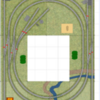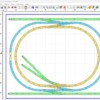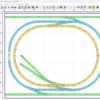For a while I have been tinkering around in AnyRail on my layout design for the back bedroom. Recently I had thought about how all this would come together by power supplies, power districts, isolated rails, all the good stuff that I have at least an idea of, but not much else. The rails are all Ross rails, the dimensions of the layout are 103" x 126".
The section in the middle is access as well as where control would come from. I plan to have two bridges to pass over the crazy river pictured at the bottom of the layout, there will be a car tunnel on the right side where the road goes through, and not sure if the river would also be through that tunnel or a archway for it. The topside of the layout would be the highlands and have it slope downwards to the river. The station in the lower left corner would be built up to the track, sort of like how the station downtown of the BR&W is, not sure how I would do that exactly, but that is the plan. The road that passes that would would be in the lowlands.
I threw in some buildings for something to show, but have some ideas for others. Top left corner I plan to have a dairy processor for the numerous amount of milk cars I have, I have on the opposite side in the top right corner a coaling tower(hard to make out) for numerous amounts of coal cars I have. Station in the lower left of course, I have on the inner siding mid-left sanding and water tower which I also have but not sure where a water column I bought in 2020. I also have a building I labeled facilities which is undetermined as to what exactly that could be. The lower right corner I have an outline of an invisible representation of a freight building I bought at York some years ago.
The rest of the buildings, and trees are subject to interpretation as they are just there to represent what else could be there. I figured I would place stuff in there just to give it a little bit more stuff basically just to be filler. There will probably be a little bit more road added which more than likely would be on the right side going up to the highlands in some fashion, perhaps that would be fenced off for railroad use only.
So, with all that of course there are the questions that need to be answered. I went back into AnyRail, snapped a clean picture so I could see the rails without labels, get an idea of where spots are for isolation of rails, and be able to ask about power. So, in red below would be where isolating track pins for the center rails would be applied to isolate power districts and or rails. I figured that maybe two power supplies could be what would be for this, inner loop on one power supply, outer on another power supply. The isolated sections would be powered by the two power supplies individually on whichever is the main power supply for the loop they fall into.
I would imagine that of course I would need power drops for bus lines. I figure that this should be a fairly easy project, which of course will be something I nitpick at at how much I want to put into it, make it better than what I think it is. I tend to be a pain working on my projects much like everyone else that wants to get things right.























